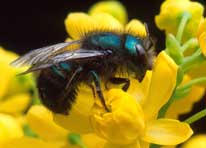The Orchard Mason Bees
World's Best Pollinators

Orchard Mason Bees may be the best thing that happens to your garden, even if you never heard of them. Sometimes called the orchard bee or blue orchard bee, these incredible non-aggressive bees don't even look like bees. As you can see from the photo, these beneficial insects look more like black flies and have a blue tint in the sunlight. You've probably seen them many times and never knew what they were.
There are approximately 4000 species of native bees in North America. So what is so special about these bees? Glad you asked. In one word, everything! But here's the longer version. First, orchard bees are prolific pollinators, far more efficient than honeybees. In case you didn't know, honey bees were introduced to the U.S. from Europe with the first settlers to the New World.
How Blue Orchard Bees Benefit Commercial Growers
What may be most important to growers and commercial gardeners is these industrious bees are several times more efficient at pollination than honey bees. They have no hives, so every bee is a pollinator. Gathering pollen is an essential part of their life's purpose. Amazingly, 250 mason bees can do the same job as 20,000 honey bees. With honey bees in decline, renewed attention is being paid to this perfect pollinator. Even large commercial orchards are making use of this bee.
How Blue Orchard Bees Benefit Homeowners
What may be most important to home owners is that most of America's native bees are solitary in nature and are totally non-aggressive. They rarely sting, do not swarm, and do not produce honey. On the extremely rare occasion one does sting, it feels more like a mosquito bite than a bee sting.
It is just what author Brian Griffin said in his book, The Orchard Mason Bee, "If you believe nature has a purpose for all Earth's creatures, then... the Orchard Mason Bee was put on Earth to pollinate."
Reproduction and pollination seems to be their purpose in life. While a favorite for this bee is fruit tree blossoms, in the absence of their favorite blossoms they will visit most blossoms and flowers available to them.
Many people build or purchase native bee houses and set them up in their garden, balcony, patio, nursery or orchard. Once the house is set up, it takes only about an hour each year to perform required maintenance. These wonderful bees have quite a following. Not only do they make a great hobby or school project, but they provide an important function in plant pollination.
Find out more about this friendly bee and how you can benefit from this amazing little creature. The pages in this section will teach you how to attract and manage your own mason bees.
Note: We will be adding more pages on the blue orchard bee in the coming days so you will have everything you need before the bees become active throughout most of the U.S.
Mason Bee Pollination vs Honeybee Pollination
Both mason bees and honeybees are incredibly beneficial to life on earth. Both bees pollinate, but their methods are different. Find out why researchers say the mason bees are the better pollinator.
The Orchard Mason Bee's Life Cycle and Behavior
Learn about our native Orchard Mason Bee life cycle. You will also see why this bee is so gentle and great for home gardens and backyard orchards.
Protecting Your Bees From Pollen Mites
Pollen mites can harm your bees. If you harvest your mason bee cocoons (and you should), learn how to remove mites from bee cocoons to ensure a good spring emergence.
Popular Types of Mason Bee Houses Examine the popular types of mason bee houses, including pros and cons, for making the best choice.
Harvesting and Cleaning Mason Bee Cocoons
Mason bee cocoons need to be removed at the end of the season. This will keep emerging bees healthy and helps protect the next generation. Find out how to harvest cocoons here.
Orchard Mason Bees to Lawn Care Academy Home

